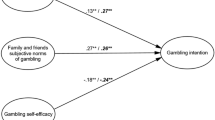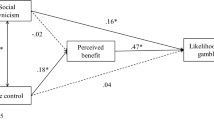Abstract
Investigating how gambling frequency and perceptions towards gambling relate to gambling problems has direct relevance for prevention and treatment programs. Accordingly, this study explored the relationship between a diverse group of gambling beliefs, the intention to gamble, gambling frequency, and gambling problems. To facilitate this, the Theory of Planned Behaviour (TPB) was employed to model the influence of gambling attitudes (e.g., the expected emotional and financial outcomes from gambling), social norms (e.g., perceived approval and gambling behaviour of significant others) and cognitive biases (confidence in the ability to determine the outcome of gambling) on the intention to gamble, gambling frequency, and gambling problems. Two hundred and one volunteers completed a questionnaire that assessed these social-cognitive factors and gambling behaviours. Consistent with expectations, the path analysis revealed the TPB determinants predicted gambling frequency and gambling problems, respectively. Interestingly though, there was the direct path between the intention to gamble and gambling problems, and attitudes and gambling frequency. The potential implications for these findings are discussed.


Similar content being viewed by others
References
Afifi, T., LaPlante, D., Taillieu, T., Dowd, D., & Shaffer, H. (2014). Gambling involvement: considering frequency of play and the moderating effects of gender and age. International Journal of Mental Health and Addiction, 12(3), 283–294. doi:10.1007/s11469-013-9452-3.
Ajzen, I. (1991). The theory of planned behavior. Organizational Behavior and Human Decision Processes, 50(2), 179–211. doi:10.1016/0749-5978(91)90020-t.
Ajzen, I. (2002). Constructing a TpB questionnaire: Conceptual and methodological considerations. Retrieved May, 3, 2010, from http://www-unix.oit.umass.edu/~aizen/index.html
Ajzen, I. (2005). Attitudes, personality and behaviour (2 ed., ). Maidenhead: Open University Press.
Ajzen, I. (2012). Martin fishbein’s legacy. The Annals of the American Academy of Political and Social Science, 640(1), 11–27. doi:10.1177/0002716211423363.
Armitage, C. J., & Christian, J. (2003). From attitudes to behaviour: basic and applied research on the theory of planned behaviour. Current Psychology: Developmental, Learning, Personality, Social, 22, 187–195. doi:10.1007/s12144-003-1015-5.
Armitage, C. J., & Conner, M. (2001). Efficacy of the theory of planned behaviour: a meta-analytic review. British Journal of Social Psychology, 40(4), 471.
Armitage, C. J., Norman, P., & Conner, M. (2002). Can the theory of planned behaviour mediate the effects of age, gender and multidimensional health locus of control? British Journal of Health Psychology, 7(3), 299–316.
Blume, S. B. (1987). Compulsive gambling and the medical model. Journal of Gambling Studies, 3(4), 237–247. doi:10.1007/BF01019883.
Bouju, G., Hardouin, J.-B., Boutin, C., Gorwood, P., Bourvellec, J.-D., Feuillet, F., et al. (2014). A shorter and multidimensional version of the gambling attitudes and beliefs survey (GABS-23). Journal of Gambling Studies, 30(2), 349–367. doi:10.1007/s10899-012-9356-3.
Currie, S. R., Hodgins, D. C., Casey, D. M., & el-Guebaly, N. (2012). Examining the predictive validity of low-risk gambling limits with longitudinal data. Addiction, 107(2), 400–406. doi:10.1111/j.1360-0443.2011.03622.x
Dechant, K. (2014). Show me the money: incorporating financial motives into the gambling motives questionnaire. Journal of Gambling Studies, 30(4), 949–965. doi:10.1007/s10899-013-9386-5.
Fishbein, M., & Ajzen, I. (1975). Belief, attitude, intention and behavior: An introduction to theory and research. Reading, MA: Addison-Wesley.
Flack, M., & Morris, M. (2014). Problem gambling: one for the money…? Journal of Gambling Studies, 1-18. doi:10.1007/s10899-014-9484-z.
Gagnon, H., & Godin, G. (2009). Psychosocial factors explaining drug users' intention to use a new syringe at each injection. Addiction Research & Theory, 17, 481–492.
Haagsma, M., King, D., Pieterse, M., & Peters, O. (2013). Assessing problematic video gaming using the theory of planned behavior: a longitudinal study of Dutch young people. International Journal of Mental Health and Addiction, 11(2), 172–185. doi:10.1007/s11469-012-9407-0.
Hansen, M., & Rossow, I. (2008). Adolescent gambling and problem gambling: does the total consumption model apply? Journal of Gambling Studies, 24(2), 135–149. doi:10.1007/s10899-007-9082-4.
Hansen, M. B., & Rossow, I. M. (2012). Does a reduction in the overall amount of gambling imply a reduction at all levels of gambling? Addiction Research & Theory, 20(2), 145. doi:10.3109/16066359.2011.605968.
Hing, N., Lamont, M., Vitartas, P., & Fink, E. (2015). Sports-embedded gambling promotions: a study of exposure, sports betting intention and problem gambling amongst adults. International Journal of Mental Health and Addiction, 13(1), 115–135. doi:10.1007/s11469-014-9519-9.
Kassinove, J. I., Tsytsarev, S. V., & Davidson, I. (1998). Russian attitudes toward gambling. Personality and Individual Differences, 24(1), 41–46. doi:10.1016/S0191-8869(97)00152-9.
Kessler, R. C., Hwang, I., LaBrie, R., Petukhova, M., Sampson, N. A., Winters, K. C., et al. (2008). DSM-IV pathological gambling in the national comorbidity survey replication. Psychological Medicine, 38, 1351–1360. doi:10.1017/S0033291708002900.
Kline, R. B. (2005). Principal and practice of structural equation modeling (Second ed., ). New York: Guilford Press.
Ladouceur, R., & Walker, M. (1996). A cognitive perspective on gambling. In P. M. Salkovski (Ed.), Trends in cognitive and behavioural therapies (pp. 89–120). Chichester: John Wiley & Sons.
LaPlante, D. A., Nelson, S. E., Labrie, R. A., & Shaffer, H. J. (2011). Disordered gambling, type of gambling and gambling involvement in the British gambling prevalence survey 2007. European Journal of Public Health, 21(4), 532–537. doi:10.1093/eurpub/ckp177.
Larimer, M. E., & Neighbors, C. (2003). Normative misperception and the impact of descriptive and injunctive norms on college student gambling. Psychology of Addictive Behaviors, 17(3), 235–243. doi:10.1037/0893-164X.17.3.235.
Larimer, M. E., Neighbors, C., Lostutter, T. W., Whiteside, U., Cronce, J. M., Kaysen, D., et al. (2012). Brief motivational feedback and cognitive behavioral interventions for prevention of disordered gambling: a randomized clinical trial. Addiction. doi:10.1111/j.1360-0443.2011.03776.x.
Lawton, R., Conner, M., & Parker, D. (2007). Beyond cognition: predicting health risk behaviors from instrumental and affective beliefs. Health Psychology, 26(3), 259–267. doi:10.1037/0278-6133.26.3.259.
Lee, H.-S. (2013). Predicting and understanding undergraduate students’ intentions to gamble in a casino using an extended model of the theory of reasoned action and the theory of planned behavior. Journal of Gambling Studies, 29(2), 269–288. doi:10.1007/s10899-012-9302-4.
MacKillop, J., Anderson, E., Castelda, B., Mattson, R., & Donovick, P. (2006). Divergent validity of measures of cognitive distortions, impulsivity, and time perspective in pathological gambling. Journal of Gambling Studies, 22(3), 339–354. doi:10.1007/s10899-006-9021-9.
MacLaren, V., Ellery, M., & Knoll, T. (2015). Personality, gambling motives and cognitive distortions in electronic gambling machine players. Personality and Individual Differences, 73(0), 24–28. doi: 10.1016/j.paid.2014.09.019
Martin, R. J., Usdan, S., Nelson, S., Umstattd, M. R., LaPlante, D., Perko, M., et al. (2010). Using the theory of planned behavior to predict gambling behavior. Psychology of Addictive Behaviors, 24(1), 89–97. doi:10.1037/a0018452.
Mattson, R., MacKillop, J., Castelda, B., Anderson, E., & Donovick, P. (2008). The factor structure of gambling-related cognitions in an undergraduate university sample. Journal of Psychopathology and Behavioral Assessment, 30(3), 229–234. doi:10.1007/s10862-007-9063-z.
McEachan, R. R. C., Conner, M., Taylor, N. J., & Lawton, R. J. (2011). Prospective prediction of health-related behaviours with the theory of planned behaviour: a meta-analysis. Health Psychology Review, 5(2), 97–144. doi:10.1080/17437199.2010.521684.
Meisel, M. K., & Goodie, A. S. (2014). Descriptive and injunctive social norms’ interactive role in gambling behavior. Psychology of Addictive Behaviors, 28(2), 592–598. doi:10.1037/a0036444.
Montaño, D. E., & Kasprzyk, D. (2008). Theory of reasoned action, theory of planned behavior, and the integrated behavioral model. In K. Glanz, B. K. Rimer, & K. Viswanath (Eds.), Health behavior and health education: theory, research, and practice (pp. 69–96). San Francisco: John Wiley.
Moore, S. M., & Ohtsuka, K. (1997). Gambling activities of young Australians: developing a model of behaviour. Journal of Gambling Studies, 13(3), 207–236. doi:10.1023/A:1024979232287.
Myklestad, I., & Rise, J. (2008). Predicting intentions to perform protective sexual behaviours among Norwegian adolescents. Sex education: sexuality, society and learning, 8(1), 107–124. doi:10.1080/14681810701811886.
Myrseth, H., Brunborg, G., & Eidem, M. (2010). Differences in cognitive distortions between pathological and non-pathological gamblers with preferences for chance or skill games. Journal of Gambling Studies, 26(4), 561–569. doi:10.1007/s10899-010-9180-6.
Neighbors, C., Lostutter, T., Whiteside, U., Fossos, N., Walker, D., & Larimer, M. (2007). Injunctive norms and problem gambling among college students. Journal of Gambling Studies, 23(3), 259–273. doi:10.1007/s10899-007-9059-3.
Norman, P., Armitage, C. J., & Quigley, C. (2007). The theory of planned behavior and binge drinking: assessing the impact of binge drinker prototypes. Addictive Behaviors, 32(9), 1753–1768. doi:10.1016/j.addbeh.2006.12.009.
Oei, T. P., Lin, J., & Raylu, N. (2008). The relationship between gambling cognitions, psychological states, and gambling: a cross-cultural study of Chinese and Caucasians in Australia. Journal of Cross-Cultural Psychology, 39(2), 147–161. doi:10.1177/0022022107312587.
Orford, J., Griffiths, M., Wardle, H., Sproston, K., & Erens, B. (2009). Negative public attitudes towards gambling: findings from the 2007 British gambling prevalence survey using a new attitude scale. International Gambling Studies, 9(1), 39–54. doi:10.1080/14459790802652217.
Phillips, J., Ogeil, R., Chow, Y.-W., & Blaszczynski, A. (2013). Gambling involvement and increased risk of gambling problems. Journal of Gambling Studies, 29(4), 601–611. doi:10.1007/s10899-012-9325-x.
Productivity, C. (2010) Gambling. Canberra: Productivity Commission
Shead, W. N., & Hodgins, D. (2009). Affect-regulation expectancies among gamblers. Journal of Gambling Studies, 25(3), 357–375. doi:10.1007/s10899-009-9131-2.
Smith, D. P., Pols, R. G., Battersby, M. W., & Harvey, P. W. (2013). The gambling urge scale: reliability and validity in a clinical population. Addiction Research & Theory, 21(2), 113–122. doi:10.3109/16066359.2012.696293.
Steenbergh, T. A., Meyers, A. W., May, R. K., & Whelan, J. P. (2002). Development and validation of the gamblers' beliefs questionnaire. Psychology of Addictive Behaviors, 16(2), 143–149. doi:10.1007/s10899-011-9286-5.
Stewart, S. H., & Zack, M. (2008). Development and psychometric evaluation of a three-dimensional gambling motives questionnaire. Addiction, 103(7), 1110–1117. doi: doi:10.1111/j.1360-0443.2008.02235.x
Strong, D. R., Breen, R. B., & Lejuez, C. W. (2004). Using item response theory to examine gambling attitudes and beliefs. Personality and Individual Differences, 36(7), 1515–1529. doi:10.1016/j.paid.2003.06.001.
Wohl, M. J. A., Young, M. M., & Hart, K. E. (2007). Self-perceptions of dispositional luck: relationship to dsm gambling symptoms, subjective enjoyment of gambling and treatment readiness. Substance Use & Misuse, 42(1), 43–63. doi:10.1080/10826080601094223.
Wood, R. T. A., & Griffiths, M. D. (2007). A qualitative investigation of problem gambling as an escape based coping strategy. Psychology & Psychotherapy: Theory, Research & Practice, 80(1), 107–125. doi:10.1348/147608306X107881.
Wu, A., & Tang, C. (2012). Problem gambling of Chinese college students: application of the theory of planned behavior. Journal of Gambling Studies, 28(2), 315–324. doi:10.1007/s10899-011-9250-4.
Wu, A. S., Lai, M. C., Tong, K., & Tao, V. K. (2013). Chinese attitudes, norms, behavioral control and gambling involvement in Macao. Journal of Gambling Studies, 29(4), 749–763. doi:10.1007/s10899-012-9344-7.
Author information
Authors and Affiliations
Corresponding author
Rights and permissions
About this article
Cite this article
Flack, M., Morris, M. Gambling-Related Beliefs and Gambling Behaviour: Explaining Gambling Problems with the Theory of Planned Behaviour. Int J Ment Health Addiction 15, 130–142 (2017). https://doi.org/10.1007/s11469-015-9611-9
Published:
Issue Date:
DOI: https://doi.org/10.1007/s11469-015-9611-9




